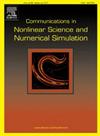Semi-wavefront for a Belousov–Zhabotinskii reaction–diffusion system with spatio-temporal delay
IF 3.4
2区 数学
Q1 MATHEMATICS, APPLIED
Communications in Nonlinear Science and Numerical Simulation
Pub Date : 2024-08-23
DOI:10.1016/j.cnsns.2024.108297
引用次数: 0
Abstract
This paper considers a Belousov–Zhabotinskii reaction–diffusion system with spatio-temporal delay. The spatio-temporal delay is modeled as the convolution of with a kernel function , where . By constructing an auxiliary system, applying Schauder’s fixed point theorem, and using a limiting argument, we demonstrate that the model admits non-negative traveling wave solutions connecting the equilibrium to some unknown positive steady states (also referred to as a semi-wavefront) when the wave speed satisfies . Moreover, no such semi-wavefront exists if . It is noteworthy that the kernel function is not required to have compact support in this analysis.
具有时空延迟的贝洛索夫-扎博金斯基反应扩散系统的半波前问题
本文研究的是一个具有时空延迟的别洛索夫-扎博金斯基反应扩散系统。时空延迟被模拟为 u(t,x) 与核函数 g(t,x)≥0 的卷积,其中∫R∫0+∞g(s,y)dsdy=1。通过构建辅助系统、应用绍德定点定理和使用极限论证,我们证明了当波速满足 c≥c∗=21-r 时,模型中存在连接平衡态(0,0)和某些未知正稳态(也称为半波前)的非负行波解。此外,如果 c<c∗ ,则不存在这样的半波前。值得注意的是,本分析不要求核函数具有紧凑的支持。
本文章由计算机程序翻译,如有差异,请以英文原文为准。
求助全文
约1分钟内获得全文
求助全文
来源期刊

Communications in Nonlinear Science and Numerical Simulation
MATHEMATICS, APPLIED-MATHEMATICS, INTERDISCIPLINARY APPLICATIONS
CiteScore
6.80
自引率
7.70%
发文量
378
审稿时长
78 days
期刊介绍:
The journal publishes original research findings on experimental observation, mathematical modeling, theoretical analysis and numerical simulation, for more accurate description, better prediction or novel application, of nonlinear phenomena in science and engineering. It offers a venue for researchers to make rapid exchange of ideas and techniques in nonlinear science and complexity.
The submission of manuscripts with cross-disciplinary approaches in nonlinear science and complexity is particularly encouraged.
Topics of interest:
Nonlinear differential or delay equations, Lie group analysis and asymptotic methods, Discontinuous systems, Fractals, Fractional calculus and dynamics, Nonlinear effects in quantum mechanics, Nonlinear stochastic processes, Experimental nonlinear science, Time-series and signal analysis, Computational methods and simulations in nonlinear science and engineering, Control of dynamical systems, Synchronization, Lyapunov analysis, High-dimensional chaos and turbulence, Chaos in Hamiltonian systems, Integrable systems and solitons, Collective behavior in many-body systems, Biological physics and networks, Nonlinear mechanical systems, Complex systems and complexity.
No length limitation for contributions is set, but only concisely written manuscripts are published. Brief papers are published on the basis of Rapid Communications. Discussions of previously published papers are welcome.
 求助内容:
求助内容: 应助结果提醒方式:
应助结果提醒方式:


